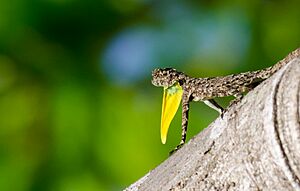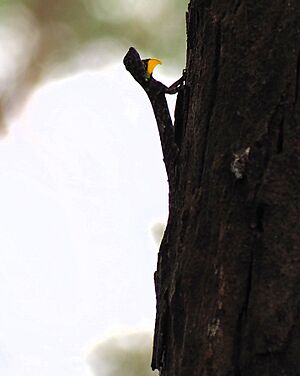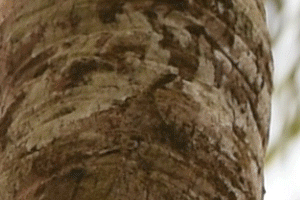Draco dussumieri facts for kids
Quick facts for kids Draco dussumieri |
|
|---|---|
 |
|
| A male with a long yellow dewlap that is rapidly flicked forward in display | |
 |
|
| A Draco dussumieri female with a relatively smaller dewlap | |
| Conservation status | |
| Scientific classification | |
| Genus: |
Draco
|
| Species: |
dussumieri
|
 |
|
| Draco dussumieri range in relation to the ranges of a few other Draco species | |
The Indian flying lizard (scientific name: Draco dussumieri) is a special type of lizard found in the forests of Southern India. It's also known as the southern flying lizard or Western Ghats flying lizard. These amazing lizards can glide from tree to tree, almost like they're flying! They spend nearly their whole lives in trees, looking for insects to eat. When they want to move to another tree, they spread out special flaps of skin on their sides, which act like wings.
Males of this species have a colorful "wing" membrane and a bright yellow throat flap, called a dewlap. They use these to show off to females and to warn other males to stay away from their space. Even though they live mostly in trees, the females come down to the ground to lay their eggs in the soil. This lizard is the only one of its kind found in western India, as most other Draco species live in Southeast Asia.
Contents
What Does It Look Like?
The southern flying lizard is usually brown with grey patches. This helps it blend in perfectly with tree bark. It can even change its color a little bit to match its surroundings better.
Adults are about 23 centimeters (9 inches) long in total. Their body, from snout to vent (where the tail starts), is about 7 to 9 centimeters (2.8 to 3.5 inches). Their tail adds another 10 to 13 centimeters (3.9 to 5.1 inches) to their length.
The lizard's head is round with a short nose, and its nostrils point upwards. It is most active during the day, especially after warming up in the morning sun.
Amazing Gliding Abilities
Males have a long yellow dewlap (a flap of skin under the throat), which is shorter in females. This lizard climbs trees to hunt for insects. When it reaches the top, it can leap off and glide to another tree!
It glides by spreading out its "patagia" (pah-TAY-jee-uh). These are flaps of skin on both sides of its body. Six long ribs support these flaps, letting the lizard extend them outwards like wings. Even the sides of its neck stretch out to form smaller "wings" around its head. The lizard uses its tail to steer while gliding.
The underside of the patagium is patterned with black spots on yellow and purple. These patterns are unique to each lizard, like fingerprints! They help scientists identify individual lizards and estimate how many are in an area.
You might also notice a small, horn-like bump behind and above its eye. Males also have a small crest (a ridge) on the back of their neck.
Where Do They Live?
The Indian flying lizard mainly lives in the Western Ghats mountain range and other hill forests in southern India. You can find them in states like Karnataka, Kerala, Tamil Nadu, Goa, and Maharashtra. They have also been seen in some parts of the Eastern Ghats.
These lizards are often found in coconut and betel-nut farms that are close to forests. They love to climb and glide among the trees there.
How Do They Behave?
The southern flying lizard eats insects, especially ants. It is active only during the day and sleeps at night on flat surfaces.
Courtship and Territory
Males are very active in showing off from February to April, especially in the mornings after the sun warms them up. They keep small areas as their territory. When a male sees a female nearby, he bobs his head and extends his yellow throat pouch. He can even change his skin color to a shiny silver-grey to look more noticeable before gliding towards the female.
When a male glides, he leaps off with his back legs, using special muscles at the base of his tail. Then, he spreads his patagia. His front legs are attached to these gliding membranes during flight and are released just before he lands.
If another male lizard tries to enter his territory, the male will try to scare him away. He does this by expanding and folding his patagium and making quick, noticeable movements.
Egg Laying and Predators
During the hottest part of the day in summer, these lizards rest in the cooler tree canopy. They become active again in the late afternoon. When the weather is cooler, they bask in the sun to warm up.
Females come down to the ground to lay their eggs in the soil during the monsoon season. They usually lay about four eggs, which hatch after about 50 days.
Many animals hunt the southern flying lizard. These include snakes that live in trees and birds like the Indian golden oriole and the black-capped kingfisher. Even Lion-tailed macaques (a type of monkey) have been seen eating them.
In Fiction
The Draco dussumieri lizard is an important part of a fictional novel called Carvalho (ಕರ್ವಾಲೊ). This book was written in Kannada by Poornachandra Tejaswi. In the story, a scientist named Carvalho searches for this flying lizard in the forests of the Western Ghats in Karnataka, India.





